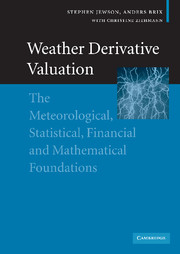 Weather Derivative Valuation
Weather Derivative Valuation Book contents
- Frontmatter
- Contents
- List of figures
- List of tables
- Acknowledgements
- 1 Weather derivatives and the weather derivatives market
- 2 Data cleaning and trends
- 3 The valuation of single contracts using burn analysis
- 4 The valuation of single contracts using index modelling
- 5 Further topics in the valuation of single contracts
- 6 The valuation of single contracts using daily modelling
- 7 Modelling portfolios
- 8 Managing portfolios
- 9 An introduction to meteorological forecasts
- 10 The use of meteorological forecasts in pricing
- 11 Arbitrage pricing models
- 12 Risk management
- 13 Modelling non-temperature data
- A Trend models
- B Parameter estimation
- C Goodness of fit tests
- D Expected pay-offs for normally distributed indices
- E Pay-off variances for normally distributed indices
- F Greeks for normally distributed indices
- G Exact solutions for the kernel density
- H The beta for a normally distributed index
- I Simulation methods
- J Efficient methods for pricing against a portfolio
- References
- Index
4 - The valuation of single contracts using index modelling
Published online by Cambridge University Press: 22 September 2009
- Frontmatter
- Contents
- List of figures
- List of tables
- Acknowledgements
- 1 Weather derivatives and the weather derivatives market
- 2 Data cleaning and trends
- 3 The valuation of single contracts using burn analysis
- 4 The valuation of single contracts using index modelling
- 5 Further topics in the valuation of single contracts
- 6 The valuation of single contracts using daily modelling
- 7 Modelling portfolios
- 8 Managing portfolios
- 9 An introduction to meteorological forecasts
- 10 The use of meteorological forecasts in pricing
- 11 Arbitrage pricing models
- 12 Risk management
- 13 Modelling non-temperature data
- A Trend models
- B Parameter estimation
- C Goodness of fit tests
- D Expected pay-offs for normally distributed indices
- E Pay-off variances for normally distributed indices
- F Greeks for normally distributed indices
- G Exact solutions for the kernel density
- H The beta for a normally distributed index
- I Simulation methods
- J Efficient methods for pricing against a portfolio
- References
- Index
Summary
Statistical modelling methods
We now investigate the possible use of statistical modelling in the hope that it might be more accurate than burn, and perhaps have other benefits too. We could, in principle, use a statistical model at any stage of the settlement process of a weather derivative. For example, for an HDD-based contract the settlement process consists of the following stages.
Collect daily Tmin and Tmax values.
Calculate Tavg.
Calculate daily HDD values.
Calculate the total HDD value.
Calculate the pay-off.
We could thus use a statistical model for any of the following.
Daily Tmin and Tmax.
Daily Tavg.
Daily HDD values.
The total HDD value.
The pay-off value.
We now discuss each of these in turn. The Tmin and Tmax time series could be modelled as stochastic time series. Looking at figure 1.1 we see that they show significant seasonal cycles in mean and variance, and correlations in time (autocorrelations). They are also cross-correlated at a range of lags. This is a hard statistical modelling problem, and a discussion of the methods that could be used is postponed until chapter 7. Tavg is simpler to model since there is now only one series, and hence no cross-correlations. But even modelling Tavg alone still turns out to be reasonably challenging because of the seasonality and autocorrelation of observed temperatures. Models for Tavg are considered in detail in chapter 6.
- Type
- Chapter
- Information
- Weather Derivative ValuationThe Meteorological, Statistical, Financial and Mathematical Foundations, pp. 73 - 93Publisher: Cambridge University PressPrint publication year: 2005


